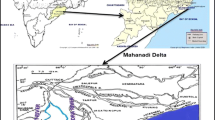Abstract
The present study focuses on the in-depth hydrologic and hydrogeologic analyses of Kathajodi-Surua Inter-basin within the Mahanadi deltaic system of Orissa, eastern India to explore the possibility of enhanced and sustainable groundwater supply. The results of 6 years (2001–2006) streamflow analysis indicated that the river flow is highly seasonal and it reduces to almost no flow during summer seasons. Land use map of the study area for the monsoon (Kharif) and post-monsoon (Rabi) seasons was developed by remote sensing technique and runoff estimation was done by curve number method. The runoff estimated for the 20-year period (1990–2009) varied from a minimum of 10.2% of the total monsoon rainfall in 1995 to a maximum of 43.3% in 2003. The stratigraphy analysis indicated that a leaky confined aquifer comprising medium to coarse sand exists at depths of 15 to 50 m and has a thickness of 20 to 55 m. The analysis of pumping test data at 9 sites by Aquifer-Test software indicated that the aquifer hydraulic conductivity ranges from 11.3 to 96.8 m/day, suggesting significant aquifer heterogeneity. Overall groundwater flow is from north-west to south-east direction. There is a 5 to 6 m temporal variation and 3 to 4 m spatial variation of groundwater levels over the basin. The rainfall-groundwater dynamics and stream-aquifer interaction in the river basin were studied by correlation analysis of groundwater level with weekly rainfall and river stage. The correlation between the weekly rainfall and weekly groundwater level was found to vary from ‘poor’ to ‘fair’ (r = 0.333 to 0.659). In contrast, the weekly groundwater level was found to be strongly correlated with the weekly river stage (r = 0.686 to 0.891). The groundwater quality was found suitable for both irrigation and drinking purposes. It is recommended that a simulation-cum-optimization modeling following an integrated approach is essential for efficient utilization of groundwater resources in the study area.



















Similar content being viewed by others
References
Al-Amoush H, Hammouri NA, Zunic F, Salameh E (2010) Intrinsic vulnerability assessment for the alluvial aquifer in the northern part of Jordan valley. Water Resour Manag 24(13):3461–3485
APHA (1989) Standard methods for the examination of water and wastewater. American Public Health Association, Port City Press, Baltimore
Ayers RS, Westcot DW (1989) Water quality for agriculture. FAO irrigation and drainage paper 29 (Rev. 1). Food and Agriculture Organization (FAO), Rome, p 174
Gupta SK, Deshpande RD (2004) Water for India in 2050: first-order assessment of available options. Curr Sci 86(9):1216–1224
Hilberg S, Schneider JF (2011) The aquifer characteristics of the dolomite formation a new approach for providing drinking water in the northern calcareous Alps region in Germany and Austria. Water Resour Manag 25(11):2705–2729
Jha MK, Chikamori K, Kamii Y, Yamasaki Y (1999) Field investigations for sustainable groundwater utilization in Konan basin. Water Resour Manag 13:443–470
Jha MK, Kamii Y, Chikamori K (2001) Irrigation and water management: an Indian perspective. Rural Environ Eng 40(2):46–66
Palmar DB (1993) Irrigation. In: Ziparo VJ, Hasen H (eds) Davis’ handbook of applied hydraulics. McGraw-Hill, New York, pp 24.1–24.36
Panda DK, Mishra A, Jena SK, James BK, Kumar A (2007) The influence of drought and anthropogenic effects on groundwater levels in Orissa, India. J Hydrol 343:140–153
Pati GC (2009) Groundwater resource scenario of Orissa. Proceedings of the Workshop on Groundwater Scenario and Quality in Orissa, 6–7 March 2009, Bhubaneswar, Orissa, India, pp. 1–8
Rejani R, Jha MK, Panda SN, Mull R (2003) Hydrologic and hydrogeologic analysis in a coastal groundwater basin, Orissa. Appl Eng Agric 19:177–184
Richards LA (1968) Diagnosis and improvement of saline and alkali soils. Handbook no. 60. US Salinity Laboratory Staff, USA, p 160
Romani S (2006) Economic sustainability of groundwater resources: need for scientific management. Keynote address in the All India Seminar on Role of Groundwater in National Economy held on 18 January 2006 at Bangalore, India
USDA Soil Conservation Service (1985) National engineering handbook. Section-4, Hydrology, Washington D.C
Todd DK (1980) Groundwater hydrology. Wiley, New York, pp 64–110
WHI (2002) AquiferTest user’s manual. Waterloo Hydrogeologic Inc., Ontario, p 270
WHO (1971) International standards for drinking water. World Health Organization, Geneva
Yin D, Shu L, Chen X, Wang Z, Mohammed ME (2011) Assessment of sustainable yield of karst water of Huaibei, China. Water Resour Manag 28(1):287–300
Yojana (2010) Yojana: water resource management. Yojana Bhavan, New Delhi, p 52
Author information
Authors and Affiliations
Corresponding author
Rights and permissions
About this article
Cite this article
Mohanty, S., Jha, M.K., Kumar, A. et al. Hydrologic and Hydrogeologic Characterization of a Deltaic Aquifer System in Orissa, Eastern India. Water Resour Manage 26, 1899–1928 (2012). https://doi.org/10.1007/s11269-012-9993-4
Received:
Accepted:
Published:
Issue Date:
DOI: https://doi.org/10.1007/s11269-012-9993-4




